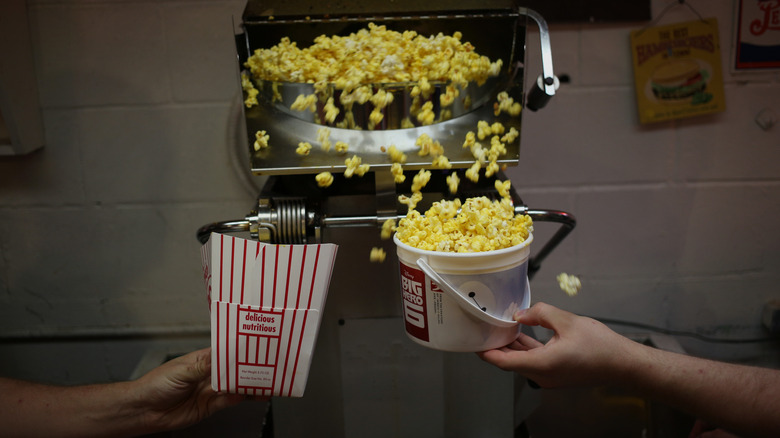How Snacks May Have Saved Movie Theaters During The Great Depression
You're sitting down in the movie theater, ready to kick back and be entertained by the latest special effects-laden blockbuster event of the summer. Like any good movie theater patron, you know watching a movie isn't complete without some sweet and salty snacks. You may have a giant tub of super buttery popcorn in your lap and a Big Gulp-sized cup of Pepsi in the chair's cupholder, or maybe you swung by the dollar store earlier and loaded up on everything from Mike & Ike's to Goobers, which you then discreetly smuggle into the theater. Whatever the case may be, the market of popcorn, soda, and boxes of candy are a key part of what keeps the movie theater's projectors running.
This isn't an exaggeration by any means, either. In 2009, Time Business reported that concession stand sales make up 85% of profits at movie theaters. You could say people just get hungry watching a movie, sure, but if you've ever been to the movies even once, you'd know that you are paying a hefty price for a bucket of popcorn. The Hustle explains that these extreme price mark-ups both offset the profit loss when selling tickets and pay off the overhead in maintaining the theater.
Of course, as expensive as these snacks are, they may have helped keep the movie industry alive during the Great Depression.
Snacks were sold for cheap to make a profit
One does not need to be a veteran historian to know that the Great Depression left many Americans without disposable income. The American people were strapped for cash and looking for ways to escape the bleak economic situation in which they found themselves. As Digital History elaborates, many Americans found comfort and morale in the films of the time, and theaters even offered special promotions and events to try and boost attendance.
According to Mental Floss, snacks helped to keep movie theaters afloat, as well. At 10 cents a bag, popcorn was enough to lure customers in with a cheap snack, while also providing a bit of extra money for the theaters themselves. Milk Duds and other cheap candies were also helpful in bringing in customers without forcing theaters to spend too much money. Ironically, movie theaters originally rebuked popcorn and other snacks, according to Smithsonian Magazine, because, at the time, theaters tried to put on an air of opulence and refinement. The idea of someone noisily chewing on popcorn while people were watching a movie and getting crumbs on the clean red carpets wasn't exactly an appealing concept to managers. In a twist of fate, theaters that focused on selling snacks were able to stay afloat during the Depression, while "fancy" theaters found themselves struggling to keep their profits from dropping.
It would seem that popcorn isn't just a delicious snack, but also a good moneymaker, too.

